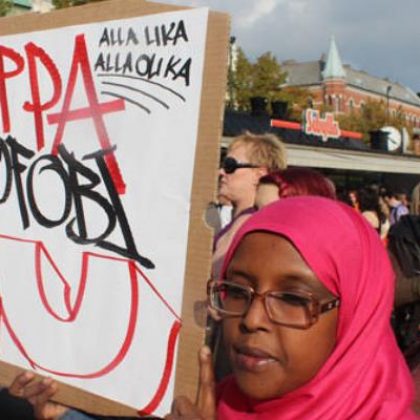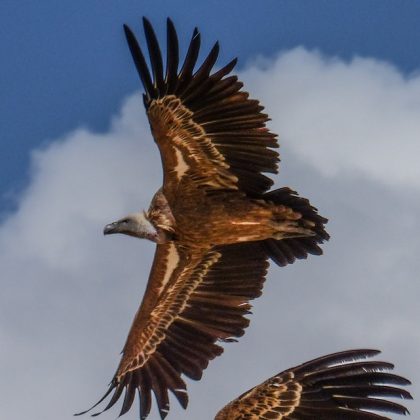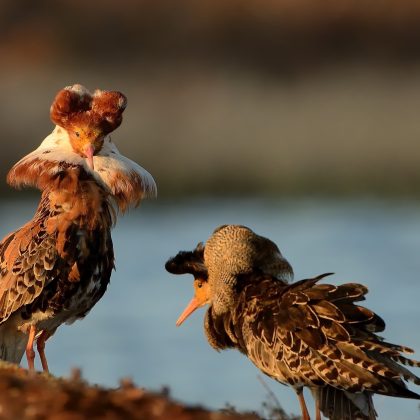Africa’s largest eagle in free fall
An iconic African eagle species made famous by TV presenter Steve Backshall is soaring towards extinction, a South African scientific study has found.
Backshall highlighted the plight of the Martial Eagle during an episode of popular ITV documentary series ‘Fierce’ when he handled a bird that had been fitted with an electronic tag for monitoring purposes. Just weeks later the bird was found dead in a hunter’s snare in a remote area of Mozambique, drawing attention to its ‘Vulnerable’ Conservation Status.
Now two University of Cape Town ornithologists have found a 60 percent decline in reported sightings of Martial Eagle sightings across South Africa over the past twenty years.
Martial Eagle sightings have dropped by as much as 60% since the late 1980s, in stark contrast to human population growth across their shared natural habitat, said the study published this week in the scientific journal Bird Conservation International. Although the exact reasons for the decline remain unclear, researchers say their findings point to an urgent need to better understand the threats to this iconic bird.
Worryingly, the study also highlighted a marked decline in Martial Eagle sightings within protected areas, including in the world famous Kruger National Park and the Kalahari Gemsbok National Park. However, declines of the species in protected areas were not as severe as elsewhere, suggesting that these areas could act to buffer the factors leading to declines.
Martial Eagles mainly prey on large birds and reptiles, and small and medium sized mammals, but are strong enough to prey on small antelopes. They typically nest in high treetops.
Their plight made international headlines last year when Mozambican hunters killed an adult bird that had featured in a British documentary starring well-known wildlife presenter Steve Backshall. At the time the bird was being tracked via a GPS satellite tag.
The research was conducted by Dr Arjun Amar and PhD student Daniël Cloete from the University of Cape Town’s FitzPatrick Institute of African Ornithology, using two Southern African Bird Atlas Project (SABAP) surveys carried out twenty years apart. Their previous research showed that comparing these surveys provided an accurate way of measuring changes in the population size of this eagle species.
Martial Eagle total population figures are still relatively inexact, but their conservation status was uplisted in 2013 from Near Threatened to Vulnerable – which means they are recognised to be globally threatened. The study published this week provides the most accurate assessment for the decline of the species in any African country and was only possible due to an army of volunteer bird watchers that contribute their sightings to the SABAP database.
The study found significant declines in three provinces; these were Kwa-Zulu Natal, Mpumalanga and Limpopo. Changes differed across the biomes (distinct regions with similar geography and climate), with the species faring worst in the Grassland, Savannah, Indian Ocean Coastal Belt and the Nama Karoo biomes. However, there was better news in the Fynbos biome of the Western and Eastern Cape, where reporting rates remained more stable over the last 20 years.
“Despite having full legal protection in South Africa, this species is known to be targeted and killed by farmers who blame the species for predation of their livestock, or may be accidentally killed by poison left to kill other predator species,” the authors noted.
Another major threat for the Martial Eagles, may be electricity infrastructure such as power lines, particularly among juveniles which have a wider territorial range.
Dr Amar, the lead author of the study said “this analysis was only possible thanks to the efforts of many hundreds of dedicated volunteer bird watchers who contribute their records to the SABAP survey database”. Dr Amar added “we have now quantified the decline of the species in South Africa, but that is the only the first step, we now need urgent research to better understand the factors which are responsible for causing this iconic species to be lost from our countryside, so that these factors can be better controlled”.
The paper is freely available for one month in the journal Bird Conservation International: “Quantifying the decline of the Martial Eagle Polemaetus bellicosus in South Africa”


Featured image credit: Martial Eagle with dwarf mongoose prey – Gillian Soames
The species lives only in Africa, and is widely distributed south of the Sahara. It is the largest Eagle species in Africa and can weight up to 6kg. More information on the species can be found here
The FitzPatrick Institute of African Ornithology in the Department of Biological Sciences at the University of Cape Town is a Centre of Excellence supported by the Department of Science and Technology and the National Research Foundation. The institute was founded in 1960 and endeavours to promote and undertake scientific studies involving birds and to contribute to the theory and practice affecting the maintenance of biological diversity and the sustained use of biological resources.
For more information, contact Dr Arjun Amar, FitzPatrick Institute of African Ornithology, NRF-DST Centre of Excellence, Biological Sciences, University of Cape Town, email: arjun.amar@uct.ac.za, tel: +27 (0)21 650 3304 or +27 (0)79 585 5603
The full citation for the paper is: Amar, A. & Cloete, D. (2017). Quantifying the decline of the Martial Eagle Polemaetus bellicosus in South Africa. Bird Conservation International.






